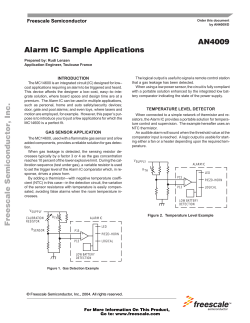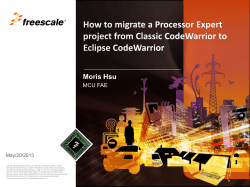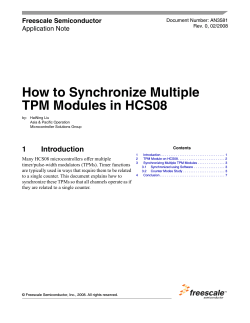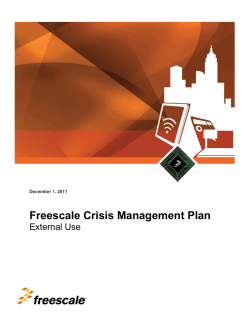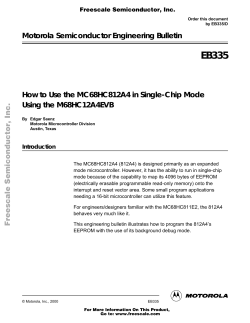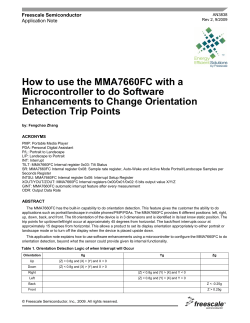
y How to Connect Multiple S/T or U ISDN
Order this document as AN2044 Freescale Semiconductor How to Connect Multiple S/T or U ISDN Interfaces to a QUICC32 - rev 0.6 Freescale Semiconductor, Inc... Freescale, Toulouse - France. INTRODUCTION y r The MC145574 (S/T interface) and MC145572 (U interface) can be gluelessly interfaced to the members of the 68302 family, using the IDL or GCI protocols, to become low cost active ISDN terminals for one basic rate connection. a n For applications that need to support more than one basic rate interface (LAN/WAN Bridges, PBX, line cards or Multiple Line Terminal Adaptors), a system solution using multiple MC145574 (S/T Interface) or MC145572 (U Interface) can be easily architectured around a QUICC32 (MC68MH360). m i i The QUICC32 and the QMC (QUICC’s Multi-channel Controller) protocol are very useful for such ISDN applications when several logical channels are transferred over the same physical medium. r P l e This application note shows how multiple MC145574 (S/T Interface) or MC145572 (U Interface) can be connected to a QUICC32. The application note describes the level 1 connections and explains the data flow through the devices. No software issues will be addressed by this application note. THE QMC PROTOCOL The QMC protocol implemented on the QUICC32, based upon the IDL bus, generates a TDM (Time Division Multiplexed) bus with programmable timeslots for each ISDN interface. Assume the creation of a 2 Mbit TDM with 32 timeslots each carrying 8 consecutive bits to form multiple 64 kbit/s channels. This is almost the same as a CEPT/E1 link. © Freescale Semiconductor, Inc., 2004. All rights reserved. Freescale Semiconductor, Inc. Timeslot zero, TS0, is dedicated to the first B1-channel. TS1 to the first B2-channel and TS2 to the first D-channel. The D-channel has 8 bits reserved on the TDM link although only 2 are used. The remaining 6 bits are masked in the QMC Time Slot Assignment Table. The reason for this is that the QMC microcode needs to process data on a 8-bits boundary to do a correct delineation between channels. The second B1-channel is routed to TS3 and thus the whole TDM built up. Freescale Semiconductor, Inc... Up to 10 BRI's can be connected this way, each BRI using 3 timeslots of the TDM line allowing a maximum of 32 channels/timeslots. Thanks to their on-chip time-slot assigner, the S/T and U interfaces, in IDL2 mode, can easily match the QMC bus structure: Both devices can be connected to a 2.048MHz IDL2 bus, and route the B1-channel, B2-channel and D-channel to any timeslot of that IDL2 bus. Figure 1 shows the IDL2 bus configured to match the QMC protocol. IDL-FSC IDL-CLK IDL-TX IDL-RX B1 B2 TS0 TS1 B1 B2 TS0 TS1 D B1 TS2 TS3 TS2 TS3 D B1 B2 D B1 B2 TS30 B2 D B1 B2 TS30 D TS31 D TS31 Figure 1: IDL2 bus structure for a connection to the QMC bus. THE CONTROL AND STATUS INFORMATION The control and status information is transferred between the QUICC32 and the ISDN interfaces via the SPI port in a out-of-band signalling method. The MC145572 also has the option of an 8 bit parallel port for control and status transfer. In this case, the U interfaces could all be connected to the processor bus instead. 2 For More Information On This Product, Go to: www.freescale.com Freescale Semiconductor, Inc. Freescale Semiconductor, Inc... Figure 2a shows the connection between the QUICC32 and an S/T interface. L1CLKx DCL L1TXDx DIN L1RXDx DOUT L1SYNC FSC IRQ GPI/O SPICLK VSS DREQ NC DGNT IRQ ISDN S/T chip MC145574 Line interface SCPEN SCPCLK SPITX SCPRX TE / NT VCC SPIRX SCPTX M/S GND QUICC32 * Pull-up resistor on SCPEN and IRQ pins are not represented Figure 2a: IDL and SCP connections between the QUICC32 and the S/T interface The QUICC32 is always a slave on the IDL/QCM bus (the DCL and FSC signals are inputs). As it is explained in the next chapter, for that specific application the S/T interface must be configured in slave mode on the IDL bus and therefore the DCL and FSC signal need to be provided to both the QUICC32 and the S/T, from external circuitry. The D-channel request/grant function is not required for this application, since it is assumed that each S/T will be directly connected to the NT1 (point to point configuration with only 1 TE connected to 1 NT). The DGNT pin is left unconnected and the DREQ can be directly connected to VSS. As there is no contention on the D-channel, the «D-channel contention procedure» of the MC145574 should be disabled, by setting the bit 6 on the register BR7. For More Information On This Product, Go to: www.freescale.com Freescale Semiconductor, Inc. Freescale Semiconductor, Inc... Figure 2b shows the connection between the QUICC32 and a U interface. L1CLKx DCL L1TXDx DIN L1RXDx DOUT L1SYNC FSX FSR IRQ GPI/O SPICLK IRQ ISDN U chip MC145572 Line interface SCPEN SCPCLK SPITX SCPRX NT / LT VCC SPIRX SCPTX M/S GND QUICC32 * Pull-up resistor on SCPEN and IRQ pins are not represented Figure 2b: IDL and SCP connections between the QUICC32 and the U interface Likewise for the S/T interface example, the U interface must be configured in slave mode and therefore the DCL and FSC signals need to be provided to both the QUICC32 and the U interface. In slave mode, the FSX and FSR pins of the MC145572 must be tied together. There are no DREQ/DGRANT signals on the U interface. DATA CLOCK (DCL) & FRAME SYNC (FSC) GENERATION: The main consideration when connecting multiple interfaces to the same physical medium, is the clock and frame sync generation. 4 For More Information On This Product, Go to: www.freescale.com Freescale Semiconductor, Inc. As stated earlier, the QUICC32 does not provide DCL and FSC. The U or S/T interface could be configured in Master Mode on the IDL bus and generate both DCL and FSC synchronised to the signal coming from the line interface. In the case of a multiple interface architecture, and in order to have all the B and D channels synchronised on the same TDM bus, only one S/T or U interface should be configured as master and provide DCL and FSC to the QUICC32 and to all the other interfaces. Freescale Semiconductor, Inc... However, this concept works only if we can guarantee that the S/T or U interface configured as master is constantly in activated mode. Once Deactivated, the U or S/T cannot generate DCL and FSC synchronized with the network. As we can not have that guarantee, it is therefore necessary to configure all the transceivers in slave mode and to find another way to generate DCL and FSC. DCL and FSC need to be synchronised to the network and cannot be derived from an independent source (e.g. crystal or oscillator). However, the S/T and U interfaces, even when they are configured as slave on the IDL bus, provide a way to generate these signals as it is explained in the following paragraphs. 1. MC145574 S/T Interface: To facilitate the generation of the timing signals required by the slave IDL interface, a pin is provided in the S/T interface. That pin (TCLK) will output a clock synchronised to the received INFO transmitted by the NT. That clock is output only when the S/T interface is activated and when the DCL and FSC signals are present (both conditions are required simultaneousely). This TCLK pin can be used to provide network timing. Its frequency is selectable via the SCP. The TCLK pin of the MC145574 is enabled by setting the bit 5 on the register OR7. Time frequency can be selected on the registers BR13 (bit 5) and BR7 (bit 2). BR13(5) BR7(2) TCLK 0 0 2.56 MHz 0 1 2.048 MHz 1 0 1.536 MHz 1 1 512 KHz The TCLK pin configured as a 2.048MHz clock, can be used as the DCL for the IDL bus. Divided by 256, that signal can also be used to generate the 8kHz frame sync FSC. As that frame sync must have a pulse width situated between 1 DCL as a minimum, and 8 DCL as a maximum, some logic need to be added after the divider in order to generate a signal with a correct duty cycle. Figure 3a and figure 3b show respectively a schematic and a timing diagram for the logic which could be used to generate a 8kHz FSC with a 1DCL width pulse, from a 2.048MHz clock (TCLK). For More Information On This Product, Go to: www.freescale.com Freescale Semiconductor, Inc. Freescale Semiconductor, Inc... 8kHz Clock Duty cycle 50% D Q Divider by 256 2.048MHz Duty cycle of 50% Clock D Q FSC 2.048MHz Clock CLK Q 2.048MHz Clock CLK Flip-flop 1 Q Flip-flop 2 Figure 3a: FSC generation from a 2.048 MHz clock - Block diagram 8kHz 8kHz Clock 2.048MHz Clock 2.048MHz inverted Clock Q Flip-flop 1 Q Flip-flop 2 FSC Figure 3b: FSC generation from a 2.048 MHz clock - Timing Elastic buffers are included in the S/T interface, to allow it to operate with any phase relationship between the IDL frame sync and the network. These buffers allow the frame sync to wander with respect to the network up to 60µs peak-peak and exceed the requirements of Q.502 which states that wander up to 18µs peak-peak may arise over a 24 hours period. 6 For More Information On This Product, Go to: www.freescale.com Freescale Semiconductor, Inc. Figure 4 is a block diagram showing the connection between 4 S/T interfaces and the QUICC32. The diagram would be the same for up to 10 S/T interfaces. RAM MC145574 SCPEN1 ROM FLASH SCPEN3 SCPEN4 IRQ 1 SCPEN1 SCPEN2 TCLK IRQ S/T MC145574 SCPEN2 IDL2 I/O Management Port SCPEN SCP SPI IRQ2 SCPEN TCLK IRQ S/T SCC1 SCC2 QUICC32 33 MHz TSA SCC3 MC145574 IDL2 SCPEN3 IDL2 BRG4 I/O INT IRQ3 IRQ 4 IRQ 3 IRQ 2 IRQ 1 SCPEN TCLK IRQ S/T MC145574 SCPEN4 IDL2 IRQ 4 SCPEN TCLK IRQ SEL MUX IDL2 FSC Freescale Semiconductor, Inc... IDL2 IDL2 DCL DIVIDER by 256 (FRAME SYNC GENERATOR) Figure 4: Connection between 4 S/T interfaces and the QUICC32 Activation procedure: For More Information On This Product, Go to: www.freescale.com S/T Freescale Semiconductor, Inc. When none of the S/T transceivers are activated, no TCLK clock is generated. Once the first S/T is being activated, it will try to generate the TCLK signal. But in order to output that signal the S/ T requires a DCL and a FSC. To allow the generation of that TCLK signal, pseudo DCL and FSC signals could be generated using one of the Baud Rate Generator (BRG) of the QUICC32. The BRG can output a clock, which frequency is a division of the system clock of the QUICC32. The divider factor should be chosen so that the BRG frequency is close to 2048MHz. That clock should be feed to the Divider-by-256 circuitry previously used with the exact 2048MHz clock, to allow the generation of a pseudo DCL and a pseudo FSC. Freescale Semiconductor, Inc... A multiplexer commanded by the QUICC32, is required to select either the BRG pin or the TCLK pins of the S/T, to be the clock master to generate the DCL and FSC signals. Then, when no S/T is activated the QUICC32 selects the BRG to be the clock master and the S/T interface receives the pseudo signals DCL and FSC (these 2 signals are not synchronized to the network but are not used to sample data!). When the first S/T is being activated, it will be able to generate the TCLK signal (as it receives DCL & FSC). That S/T interface send an interrupt to the QUICC32 (IRQ3 - register NR3 bit 3 which means that INFO2 has been received) indicating that the activation process has begun. The QUICC32 has then the ability to select, through the multiplexer, the TCLK pin of that MC145574 to be the timing master. As shown in figure 5a & 5b the TCLK signal is present before the interruption, and there is at least 750µs between the IRQ and the received INFO4. So the QUICC32 has 750µs to react to the IRQ and to select, through the multiplexer, another clock master. 8 For More Information On This Product, Go to: www.freescale.com Freescale Semiconductor, Inc. TE NT TX RX Info 0 Info 2 RX TX TX 3 1 TCLK Enabled IRQ3 TX (Rx Info 2) Info 3 RX 2 Freescale Semiconductor, Inc... RX Info 0 RX Info 4 IRQ3 TX (Rx Info 3) IRQ3 (Rx Info 4) 1 : 1250 to 1500µs (= 5 to 6 S/T Frames x 250µs) 2 : > 750µs (= 3 S/T Frames x 250µs) 3 : > 300µs Figure 5a: Timing Diagram for an Activation Initiated by the NT For More Information On This Product, Go to: www.freescale.com Freescale Semiconductor, Inc. TE NT TX RX Info 0 Info 1 2 Freescale Semiconductor, Inc... RX TX RX TX RX Info 2 Info 0 IRQ3 (Rx Info 1) TX RX Info 3 IRQ3 (Rx Info 0) RX 1 TX Info 0 5 3 TCLK Enabled 4 IRQ3 TX (Rx Info2) RX Info 4 IRQ3 TX (Rx Info 3) IRQ3 (Rx Info 4) Time 1 : 500 to 750µs (= 2 to 3 S/T Frames x 250µs) 2 : ≅ 0µs 3 : 1000 to 1500µs (= 4 to 6 S/T Frames x 250µs) 4 : > 1000µs (= 4 S/T Frames x 250µs) 5 : > 300µs Figure 5b: Timing Diagram for an Activation Initiated by the TE Desactivation procedure: When the S/T interface whose TCLK is the timing master (selected on the multiplexer) is deactivated, the QUICC32 receives an interrupt indicating the deactivation status (IRQ3 - register 10 For More Information On This Product, Go to: www.freescale.com Freescale Semiconductor, Inc. NR3 bit 3 - which means that INFO0 has been received). Then, if none of the other S/T are activated, the QUICC32 can select the BRG to be the clock master. If one (or more) S/T is activated, its TCLK pin must be selected to become the clock master. As shown in figure 6 the TCLK signal is disabled about 72.8µs after the interruption. Therefore, the QUICC32 has 72.8µs to react to the IRQ and to select, through the multiplexer, another clock master. NT TX RX Info 4 Info 0 RX TX TX 1 RX Info 3 IRQ3 TX (Rx Info 0) Info 0 RX 2 Freescale Semiconductor, Inc... TE TCLK Disabled IRQ3 (Rx Info 0) Time 1 : 500µs (= 2 S/T Frames x 250µs) 2 : 72.8µs (= 14 bit x 5.2µs) Figure 6: Timing Diagram for a Deactivation (Always Initiated by the NT) For More Information On This Product, Go to: www.freescale.com Freescale Semiconductor, Inc. 2. MC145572 U Interface: A pin which can output a clock synchronised to the network timing is also provided in the U interface (FREQREF pin). That 2.048MHz clock (the frequency is not selectable) is enabled by setting bit 4 of OR8 in the MC145572 Register set. Freescale Semiconductor, Inc... The way the FREQREF pin operates is different than for the TCLK pin of the S/T interface. When enabled, the FREQREF pin outputs the 2.048MHz clock, whatever the activation status of the U interface (but that clock is synchronize to the network only when the U interface is activated). That pin does not require the DCL & FSC signals, to be able to generate the clock. As for the S/T interface, the FREQREF pin can be used as the DCL for the IDL bus. Divided by 256, that signal can also be used to generate the 8kHz frame sync FSC. The same kind of logic as for the S/T must be added to get a correct FSC duty cycle. As for the S/T, elastic buffers are included to allow the U interface to operate with any phase relationship between the IDL frame sync and the network. Figure 7 is a block diagram showing the connection between 4 U interfaces and the QUICC32. The diagram would be the same for up to 10 U interfaces. 12 For More Information On This Product, Go to: www.freescale.com Freescale Semiconductor, Inc. RAM MC145572 SCPEN1 IDL2 FLASH SCPEN3 SCPEN4 IRQ 1 SCPEN1 SCPEN2 SPI IRQ2 U DC Metallic Termination U DC Metallic Termination U DC Metallic Termination U SCPEN FREQREF IRQ SCC1 SCC2 QUICC32 33 MHz I/O TSA SCC3 MC145572 IDL2 SCPEN3 IDL2 INT IRQ3 SCPEN FREQREF IRQ MC145572 SCPEN4 IDL2 IRQ 4 SCPEN FREQREF IRQ SEL MUX IDL2 FSC Management Port DC Metallic Termination MC145572 SCPEN2 IDL2 I/O FREQREF IRQ SCP IRQ 4 IRQ 3 IRQ 2 IRQ 1 Freescale Semiconductor, Inc... ROM SCPEN IDL2 DCL DIVIDER by 256 (FRAME SYNC GENERATOR) Figure 7: Connection between 4 U interfaces and the QUICC32 For More Information On This Product, Go to: www.freescale.com Freescale Semiconductor, Inc. Activation procedure: During the initialisation, the FREQREF pin of each U interface is enabled. A multiplexer, commanded by the QUICC32, is used to select which U interface is the clock master. Freescale Semiconductor, Inc... When the first U interface is activated, its FREQREF pin becomes synchronised to the network. The MC145572 send an interrupt to the QUICC32 (IRQ1 - register NR3 bit 1 - which means that «uao = 1» has been received) indicating that the activation process has begun. Before responding to LT by «act = 1» (which will enable the data transfer), the QUICC32 has the ability to select, through the multiplexer, the FREQREF pin of that MC145572 to be the timing master. As the QUICC32 has the initiative to enable the data transfer, there is no timing constraint to react to the interrupt. Desactivation procedure: According to the ANSI specification T1.601-1988, prior to deactivating, the LT should notify the NT of the pending deactivation by clearing the M4 channel dea bit towards the NT for at least three superframes. Then, deactivate the NT by sending a deactivation request. The MC145572 has the ability to generate an interrupt after the reception of the third dea bit to 0, but also after the receiption of the second dea bit to 0. When the U interface whose FREQREF is the timing master (selected on the multiplexer) is desactivated, the QUICC32 receives an interrupt indicating that the second «dea bit = 0» has been received. The QUICC32 has then the ability to select another activated U interface (if there is one), to be the clock master.The QUICC32 has 12ms (1 superframe) before receiving the next bit dea = 0, which will indicate the pending desactivation, and therefore 12ms to react to the interrupt. If none of the U are activated, no change in the multiplex selection is required. 14 For More Information On This Product, Go to: www.freescale.com Freescale Semiconductor, Inc. Below is a summary of the main features which need to be configured for each device: S/T Interface Configuration: - IDL2 with Time-Slot Assigner (TSA enabled in reg. OR6 bit 5 to bit 7; TSA selection in reg. OR0 to OR5) - Slave mode (DCL & FSC are input) - (pin M/S to GND) - TCLK enabled at 2.048MHz (reg. OR7, bit 5=1; reg. BR13, bit 5=0; reg. BR7, bit 2=1) Freescale Semiconductor, Inc... - «D-channel contention procedure» disabled (register BR7, bit 6=1) U Interface Configuration: - IDL2 with Time-Slot Assigner (TSA enabled in reg. OR6 bit 5 to bit 7; TSA selection in reg. OR0 to OR5) - Slave mode (DCL & FSC are input) - (pin M/S to GND) - FREQREF enabled at 2.048MHz (reg. OR8, bit 4=1) QUICC32 Configuration: - SCC3 using the QMC protocol for handling the different channels of the multiplexed IDL2 bus. (D-channels are HDLC encoded/decoded and B-channels can be configured for Transparent or HDLC framing) - SCC1 can be configured for Ethernet , HDLC, Transparent or UART. - SCC2 & SCC4 can be configured for HDLC, Transparent or UART. - The SPI is connected to the SCP port of each S/T or U interface for handling configuration and control information. - For the U interface the SPI/SCP connection can be replaced by a connection of the 8 bit parallel port of the U transceiver to the processor bus of the QUICC. - One I/O pin can be dedicated for handling the SCPEN signal of each S/T or U - One Interrupt pin can be dedicated for handling the IRQ signal of each S/T or U interface. For More Information On This Product, Go to: www.freescale.com Freescale Semiconductor, Inc. REFERENCES: 1. MC68360 Quad Integrated Communications Controller User’s Manual, Freescale Inc. 1989. 2. MC68MH360 QUICC’s Multi-channel Controller User’s Manual, Freescale Inc. 1995. 3. MC145572 ISDN U-Interface Transceiver Advance Information, Freescale Inc. 1995. 4. MC145574 ISDN S/T-Interface Transceiver Advance Information, Freescale Inc. 1996. How to Reach Us: Freescale Semiconductor, Inc... Home Page: www.freescale.com E-mail: support@freescale.com USA/Europe or Locations Not Listed: Freescale Semiconductor Technical Information Center, CH370 1300 N. Alma School Road Chandler, Arizona 85224 +1-800-521-6274 or +1-480-768-2130 support@freescale.com Europe, Middle East, and Africa: Freescale Halbleiter Deutschland GmbH Technical Information Center Schatzbogen 7 81829 Muenchen, Germany +44 1296 380 456 (English) +46 8 52200080 (English) +49 89 92103 559 (German) +33 1 69 35 48 48 (French) support@freescale.com Japan: Freescale Semiconductor Japan Ltd. Headquarters ARCO Tower 15F 1-8-1, Shimo-Meguro, Meguro-ku, Tokyo 153-0064 Japan 0120 191014 or +81 3 5437 9125 support.japan@freescale.com Asia/Pacific: Freescale Semiconductor Hong Kong Ltd. Technical Information Center 2 Dai King Street Tai Po Industrial Estate Tai Po, N.T., Hong Kong +800 2666 8080 support.asia@freescale.com For Literature Requests Only: Freescale Semiconductor Literature Distribution Center P.O. Box 5405 Denver, Colorado 80217 1-800-441-2447 or 303-675-2140 Fax: 303-675-2150 LDCForFreescaleSemiconductor@hibbertgroup.com Information in this document is provided solely to enable system and software implementers to use Freescale Semiconductor products. There are no express or implied copyright licenses granted hereunder to design or fabricate any integrated circuits or integrated circuits based on the information in this document. Freescale Semiconductor reserves the right to make changes without further notice to any products herein. Freescale Semiconductor makes no warranty, representation or guarantee regarding the suitability of its products for any particular purpose, nor does Freescale Semiconductor assume any liability arising out of the application or use of any product or circuit, and specifically disclaims any and all liability, including without limitation consequential or incidental damages. “Typical” parameters which may be provided in Freescale Semiconductor data sheets and/or specifications can and do vary in different applications and actual performance may vary over time. All operating parameters, including “Typicals” must be validated for each customer application by customer’s technical experts. Freescale Semiconductor does not convey any license under its patent rights nor the rights of others. Freescale Semiconductor products are not designed, intended, or authorized for use as components in systems intended for surgical implant into the body, or other applications intended to support or sustain life, or for any other application in which the failure of the Freescale Semiconductor product could create a situation where personal injury or death may occur. Should Buyer purchase or use Freescale Semiconductor products for any such unintended or unauthorized application, Buyer shall indemnify and hold Freescale Semiconductor and its officers, employees, subsidiaries, affiliates, and distributors harmless against all claims, costs, damages, and expenses, and reasonable attorney fees arising out of, directly or indirectly, any claim of personal injury or death associated with such unintended or unauthorized use, even if such claim alleges that Freescale Semiconductor was negligent regarding the design or manufacture of the part.
© Copyright 2025
